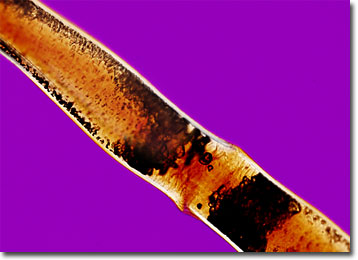Polarized Light Microscopy Digital Image Gallery
Japanese Pony Belly Hair
Ponies are not a separate species from horses, but are rather members of horse breeds that are characteristically small in stature. Their diminutive size and typically docile temperaments make the animals an excellent choice for children first learning to ride.

In addition to their use for riding, ponies also serve well as pack animals due to their impressive stamina. Indeed, the Welsh pony is a particularly hardy breed that was originally developed for use in coal mining operations. Nevertheless, some ponies are raised for reasons that are far removed from their physical prowess. Japanese ponies, for instance, are valuable for their impressively soft hair, which is a popular fiber used to construct cosmetic brushes. The luxurious pony hair has also recently gained in demand within a number of other market niches, including, shoes, clothing, and toys.
The warmth and softness of fur have made it an important resource for humans throughout history and little attention is generally paid to the application of the term. However, the pelts of animals are only properly called true furs if they are comprised of both a dense undercoat known as ground hair and an outer layer of long guard hairs. Most animals require both types of hair because they serve different functions; the ground hair maintains body temperature, while guard hair provides protection to the underlying layer. Yet, ponies are solely covered in guard hair and do not, therefore, possess true fur.
